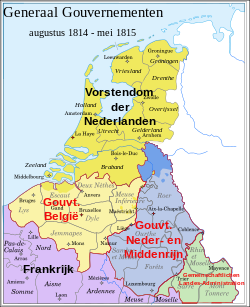
Back الإمارة السيادية للأراضي المنخفضة المتحدة Arabic Suveræne fyrstendømme de forenede Nederlande Danish Souveränes Fürstentum der Vereinigten Niederlande German Soberano Principado de los Países Bajos Unidos Spanish Ühendatud Madalmaade suveräänne vürstkond Estonian Principauté souveraine des Pays-Bas unis French הנסיכות הריבונית של ארצות השפלה HE Kepangeranan Berdaulat Belanda Bersatu ID Principato dei Paesi Bassi Uniti Italian 연합 네덜란드 주권공국 Korean
Sovereign Principality of the United Netherlands Soeverein Vorstendom der Vereenigde Nederlanden | |||||||||
|---|---|---|---|---|---|---|---|---|---|
| 1813–1815 | |||||||||
| Motto: Je maintiendrai "I will maintain" | |||||||||
| Anthem: De facto: Wilhelmus van Nassouwe "William of Nassau" | |||||||||
 The Principality shown in dark yellow | |||||||||
| Capital | Amsterdam | ||||||||
| Common languages | Dutch | ||||||||
| Religion | Dutch Reformed; Catholicism | ||||||||
| Demonym(s) | Dutch | ||||||||
| Government | Absolute monarchy (until 1814) Unitary parliamentary semi-constitutional monarchy (from 1814) | ||||||||
| Sovereign Prince | |||||||||
• 1813–1815 | William Frederick | ||||||||
| Legislature | States General | ||||||||
| Historical era | Early Modern | ||||||||
| 20 November 1813 | |||||||||
| 29 March 1814 | |||||||||
| 21 June 1814 | |||||||||
| 13 August 1814 | |||||||||
| 16 March 1815 | |||||||||
| Population | |||||||||
• 1815 | 2,233,000[1] | ||||||||
| Currency | Dutch guilder | ||||||||
| |||||||||
The Sovereign Principality of the United Netherlands (Dutch, old spelling: Souverein Vorstendom der Vereenigde Nederlanden)[2] was a short-lived sovereign principality and the precursor of the United Kingdom of the Netherlands, in which it was reunited with the Southern Netherlands in 1815. The principality was proclaimed in 1813 when the victors of the Napoleonic Wars established a political reorganisation of Europe, which would eventually be defined by the Congress of Vienna.
- ^ Demographics of the Netherlands, Jan Lahmeyer. Retrieved on 10 December 2013.
- ^ Glasius, Barend (1863). Vijftig jaren geleden. 1813–1863. 's Hertogenbosch: H. Palier en Zoon. p. 41.

